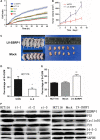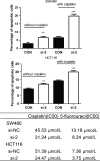SSRP1 promotes colorectal cancer progression and is negatively regulated by miR-28-5p
- PMID: 30762286
- PMCID: PMC6484412
- DOI: 10.1111/jcmm.14134
SSRP1 promotes colorectal cancer progression and is negatively regulated by miR-28-5p
Retraction in
-
Retraction: SSRP1 Promotes Colorectal Cancer Progression and is Negatively Regulated by miR-28-5p.J Cell Mol Med. 2024 Sep;28(17):e70048. doi: 10.1111/jcmm.70048. J Cell Mol Med. 2024. PMID: 39267240 Free PMC article.
Abstract
In this study, microarray data analysis, real-time quantitative PCR and immunohistochemistry were used to detect the expression levels of SSRP1 in colorectal cancer (CRC) tissue and in corresponding normal tissue. The association between structure-specific recognition protein 1 (SSRP1) expression and patient prognosis was examined by Kaplan-Meier analysis. SSRP1 was knocked down and overexpressed in CRC cell lines, and its effects on proliferation, cell cycling, migration, invasion, cellular energy metabolism, apoptosis, chemotherapeutic drug sensitivity and cell phenotype-related molecules were assessed. The growth of xenograft tumours in nude mice was also assessed. MiRNAs that potentially targeted SSRP1 were determined by bioinformatic analysis, Western blotting and luciferase reporter assays. We showed that SSRP1 mRNA levels were significantly increased in CRC tissue. We also confirmed that this upregulation was related to the terminal tumour stage in CRC patients, and high expression levels of SSRP1 predicted shorter disease-free survival and faster relapse. We also found that SSRP1 modulated proliferation, metastasis, cellular energy metabolism and the epithelial-mesenchymal transition in CRC. Furthermore, SSRP1 induced apoptosis and SSRP1 knockdown augmented the sensitivity of CRC cells to 5-fluorouracil and cisplatin. Moreover, we explored the molecular mechanisms accounting for the dysregulation of SSRP1 in CRC and identified microRNA-28-5p (miR-28-5p) as a direct upstream regulator of SSRP1. We concluded that SSRP1 promotes CRC progression and is negatively regulated by miR-28-5p.
Keywords: SSRP1; colorectal cancer; microRNA; progression.
© 2019 The Authors. Journal of Cellular and Molecular Medicine published by John Wiley & Sons Ltd and Foundation for Cellular and Molecular Medicine.
Conflict of interest statement
The authors confirm that there are no conflicts of interests.
Figures





Similar articles
-
A novel lncRNA LOC101927746 accelerates progression of colorectal cancer via inhibiting miR-584-3p and activating SSRP1.Biochem Biophys Res Commun. 2019 Feb 12;509(3):734-738. doi: 10.1016/j.bbrc.2018.12.174. Epub 2019 Jan 4. Biochem Biophys Res Commun. 2019. PMID: 30616889
-
SSRP1 Contributes to the Malignancy of Hepatocellular Carcinoma and Is Negatively Regulated by miR-497.Mol Ther. 2016 May;24(5):903-14. doi: 10.1038/mt.2016.9. Epub 2016 Jan 12. Mol Ther. 2016. PMID: 26755331 Free PMC article.
-
Role of lncSLCO1C1 in gastric cancer progression and resistance to oxaliplatin therapy.Clin Transl Med. 2022 Apr;12(4):e691. doi: 10.1002/ctm2.691. Clin Transl Med. 2022. PMID: 35474446 Free PMC article.
-
Circular RNA protein tyrosine kinase 2 (circPTK2) promotes colorectal cancer proliferation, migration, invasion and chemoresistance.Bioengineered. 2022 Jan;13(1):810-823. doi: 10.1080/21655979.2021.2012952. Bioengineered. 2022. Retraction in: Bioengineered. 2023 Dec;14(1):2269352. doi: 10.1080/21655979.2023.2269352. PMID: 34974791 Free PMC article. Retracted.
-
Genetic and epigenetic down-regulation of microRNA-212 promotes colorectal tumor metastasis via dysregulation of MnSOD.Gastroenterology. 2013 Aug;145(2):426-36.e1-6. doi: 10.1053/j.gastro.2013.04.004. Epub 2013 Apr 9. Gastroenterology. 2013. PMID: 23583431
Cited by
-
Overcoming therapeutic resistance to platinum-based drugs by targeting Epithelial-Mesenchymal transition.Front Oncol. 2022 Oct 14;12:1008027. doi: 10.3389/fonc.2022.1008027. eCollection 2022. Front Oncol. 2022. PMID: 36313710 Free PMC article. Review.
-
miR-28-5p inhibits carcinogenesis in colon cancer cells and is necessary for erastin-induced ferroptosis.Transl Cancer Res. 2020 Apr;9(4):2931-2940. doi: 10.21037/tcr-20-1809. Transl Cancer Res. 2020. PMID: 35117649 Free PMC article.
-
The Current Status of SSRP1 in Cancer: Tribulation and Road Ahead.J Healthc Eng. 2022 Apr 13;2022:3528786. doi: 10.1155/2022/3528786. eCollection 2022. J Healthc Eng. 2022. Retraction in: J Healthc Eng. 2023 May 24;2023:9875271. doi: 10.1155/2023/9875271. PMID: 35463672 Free PMC article. Retracted. Review.
-
SFPQ promotes the proliferation, migration and invasion of hepatocellular carcinoma cells and is associated with poor prognosis.Am J Cancer Res. 2023 Jun 15;13(6):2269-2284. eCollection 2023. Am J Cancer Res. 2023. PMID: 37424798 Free PMC article.
-
Lymphoma in Border Collies: Genome-Wide Association and Pedigree Analysis.Vet Sci. 2023 Sep 19;10(9):581. doi: 10.3390/vetsci10090581. Vet Sci. 2023. PMID: 37756103 Free PMC article.
References
-
- Terzić J, Grivennikov S, Karin E, Karin M. Inflammation and colon cancer. Gastroenterology. 2010;138:2101‐2114. - PubMed
-
- Huang D, Sun W, Zhou Y, et al. Mutations of key driver genes in colorectal cancer progression and metastasis. Cancer Metastasis Rev. 2018;37:173‐187. - PubMed
-
- Mathot L, Kundu S, Ljungström V, et al. Somatic ephrin receptor mutations are associated with metastasis in primary colorectal cancer. Cancer Res. 2017;77:1730‐1740. - PubMed
Publication types
MeSH terms
Substances
LinkOut - more resources
Full Text Sources
Medical
Research Materials

